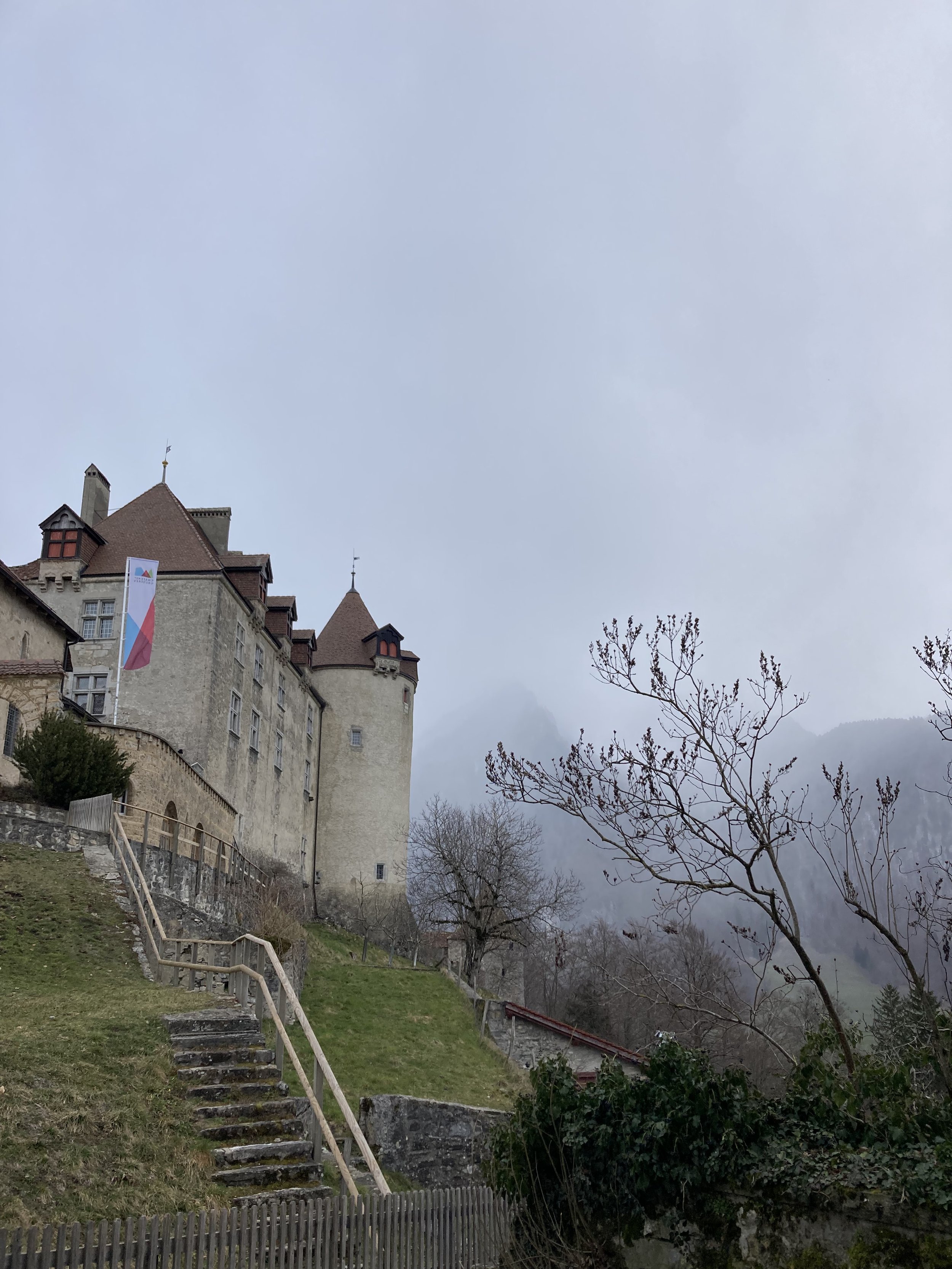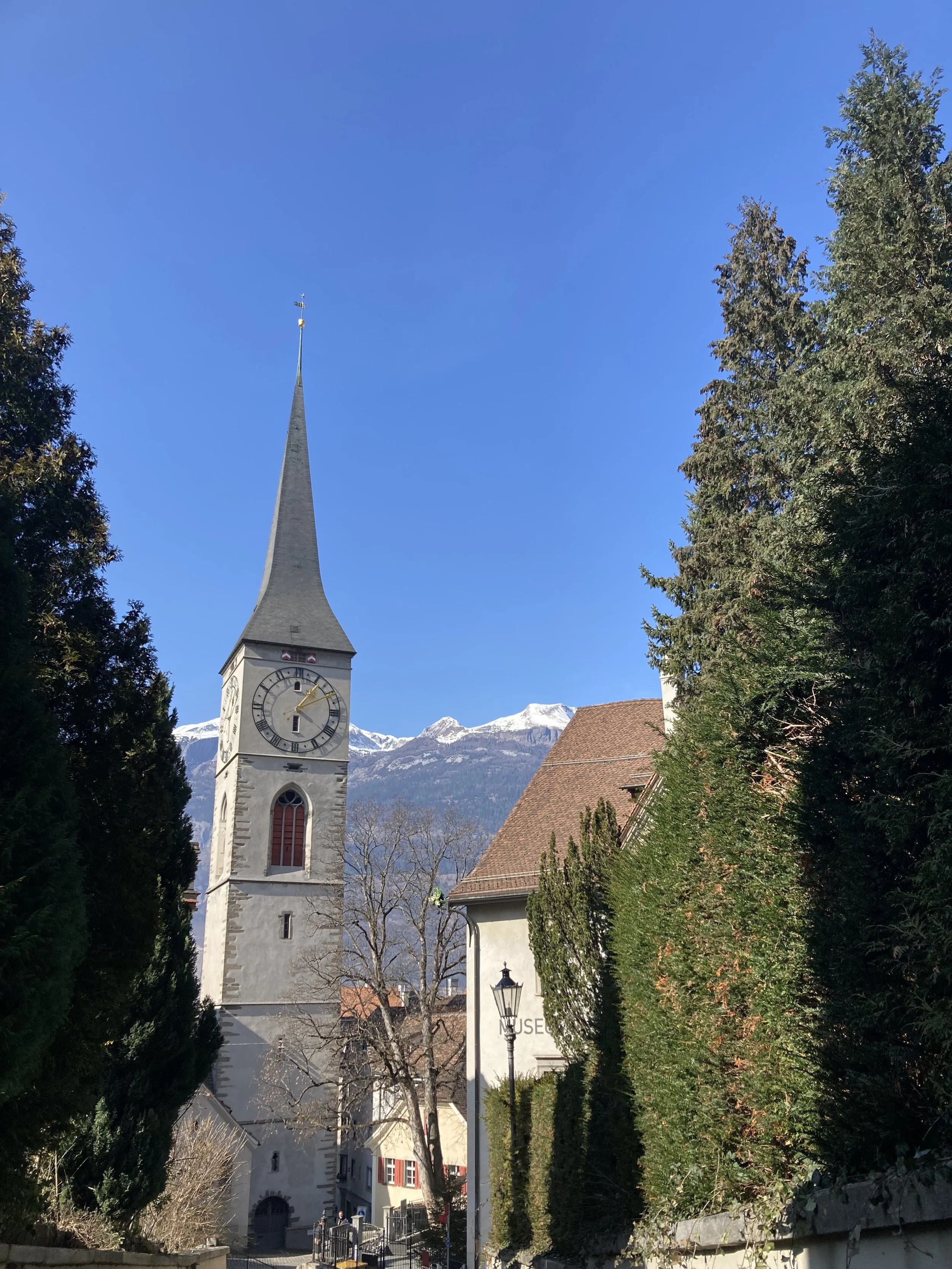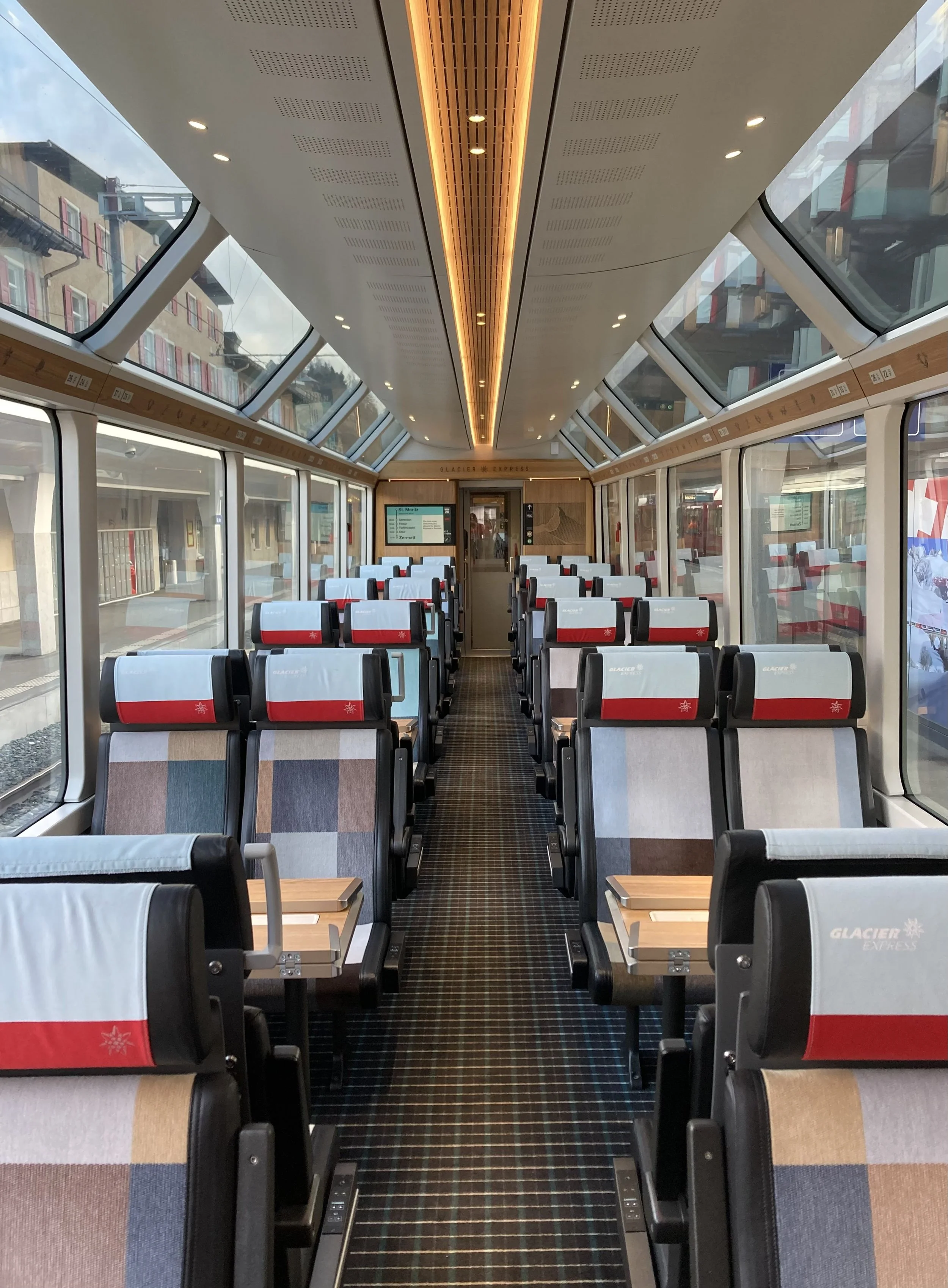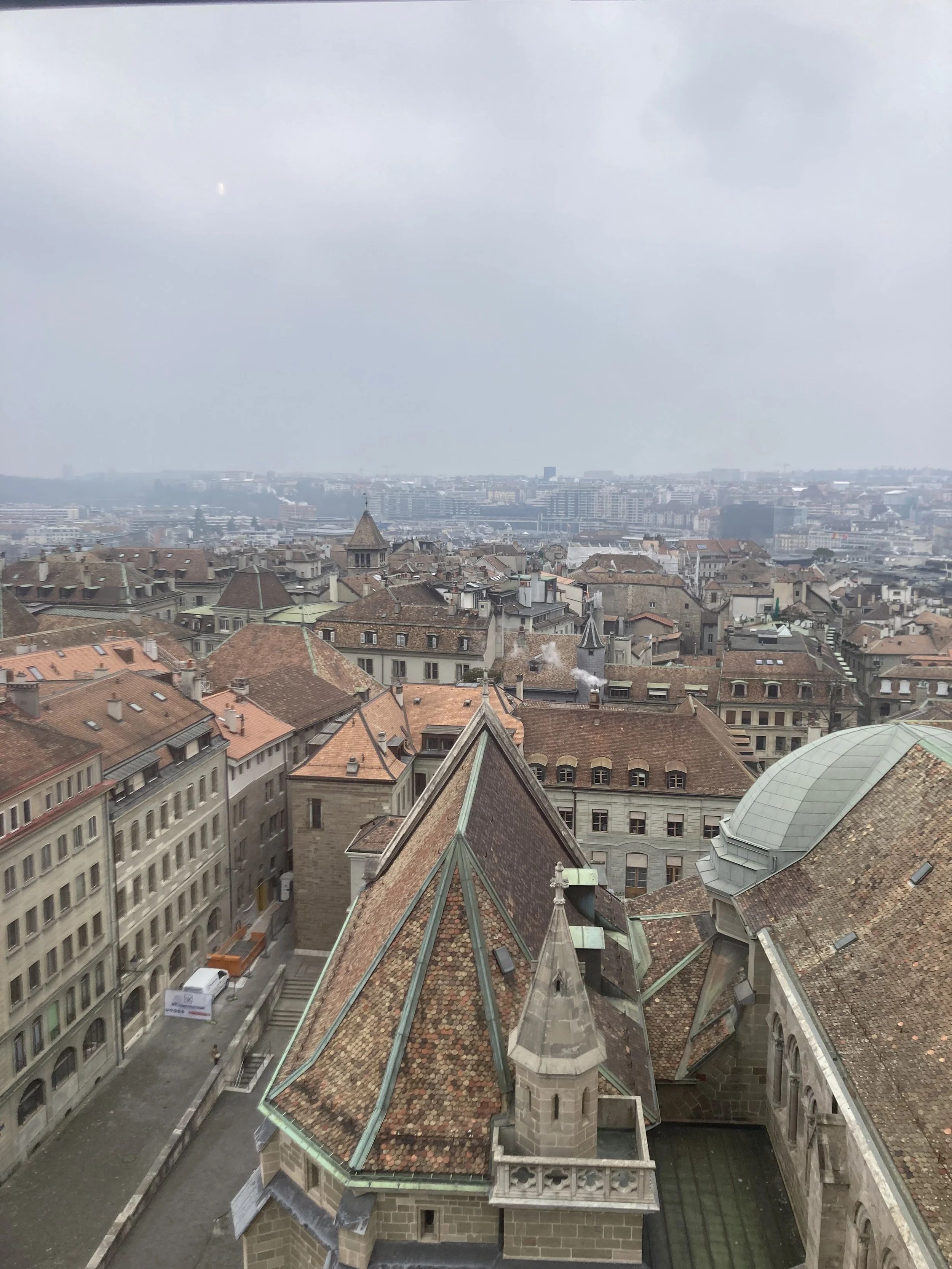By Madelynn Loring, Staff Writer
Switzerland is said to have invented the concept of winter tourism. It is the place to go in Europe for folks looking for a ski vacation or a cozy winter get-together. But there’s much to see beyond the slopes, which is what drew my father and me to this destination during my mid-semester break at the end of February.
Before I get into this article, let me make it abundantly clear that Switzerland is not a trip for everyone, especially in the winter. In the other places I’ve written about, there are things that could appeal to a huge genre of people. However, many of Switzerland’s largest tourist drives, such as the Matterhorn mountain, Aletsch glacier, and funicular railways have limited access during the winter or are closed entirely. That being said, it is the go-to in terms of winter sports getaways in Europe and also boasts a number of winter-friendly tourist attractions including museums, castles, and historic rail lines. If you are a ski buff, or if you are like me and my father (read: obsessed with trains, boats, and ruins), Switzerland is definitely the place for you, though there may be some benefit to going in the spring or summer if you are a part of the latter group.
One more quick disclaimer before we dive into it: be aware that Switzerland is one of the most expensive places to travel in Europe, as it is not a part of the EU, and thus is in a much different place economically than member countries. Be sure you look into this before you go on a trip and make sure you budget accordingly because it’s one thing to hear about it and another thing entirely when the cheapest meal you can find is a 16 CHF burger (roughly $17).
With that out of the way, let’s get into the trip. My father and I spent a week traveling throughout Switzerland, visiting the cities of Montreux, Gruyère, Interlaken/Brig, Chur, St. Moritz, and Geneva. While it was initially in our plans to visit the Matterhorn in Zermatt as well as the Aletsch glacier, we, unfortunately, ran afoul in terms of weather, making neither of these locations worth the trip in terms of both visibility and activity closures.
Montreux
We started off in Montreux, a city on the eastern end of Lake Geneva. Arguably this city's biggest claim to fame is that Freddie Mercury resided there frequently at his holiday home on the shore. There is a statue in tribute to him facing the lake, available for photo ops, and it is actually possible to rent his vacation home as a short-term rental. However, just as Freddie Mercury discovered during his vacations, Montreux is not a very bustling city. There are certainly things to do in terms of tourist attractions, but it is a very quiet town, especially during the winter.
Aside from the tribute statue, the other main tourist grab is the Chateau Chillon, about a 20-minute bus ride from the central train station. I have seen a large number of castles and palaces in my time in Europe, and there is a sense after you see enough castles that they all start to look the same. This doesn’t mean however that you should cross Chateau Chillon off your list. It is definitely more of a classic medieval defense castle than a luxurious palace, like Versailles. It is actually situated on the lake itself, a tactic dating back to its original purpose as a place of defense, though it never saw any conflict or invasions. The biggest thing that stands out about this castle compared to other castles I have seen thus far in Europe is the cavernous cellars, store rooms, and dungeon under the ground floor. There is plenty to explore in the Chateau Chillon, from decorative period furniture to modern art exhibitions scattered throughout.
Gruyère
Cheese cave at the Maison de Gruyère cheese factory
While we spent our first two nights in Montreux, we ended up taking a day trip to the town of Gruyère. And yes, before you ask, it is Gruyere, like the cheese, as this is the birthplace of Gruyere cheese. This is a must-see stop for foodies, where you can visit both the Maison de Gruyere (literally the home of gruyere cheese) as well as one of the many chocolate factories in Switzerland. While we didn’t have time to visit the latter, the Maison de Gruyere did not disappoint. An entry ticket includes an audio guide, a sampling tray of aged gruyere cheese, and a walk through their mini museum, including a view of the factory floor where you can watch the cheesemakers work. It is certainly a touristy spot, but it is very cool nonetheless.
Château de Gruyère
Our other stop in Gruyere was the Château de Gruyère. This castle looked like a fairytale, but it actually serves as more of a history lesson about Gruyere and Switzerland as a whole. Like other castles available to visit, it has its fair share of displays of medieval decorative art and weaponry. However, sitting atop one of the highest geographic points of Gruyere, it also boasts an impressive view and is a great place for pictures. It certainly isn’t the most remarkable castle I have visited in my time in Europe but is certainly one of the most notable in Switzerland.
Interlaken
Unspunnen Castle Ruins
The next city we stayed in was Interlaken. The city itself is not super impressive; it has similar vibes to Estes Park during the winter, is eerily quiet, and does not have much to do. However, it did serve as a great jumping-off point for hikes and other day trips. Our first outing of this sort was to the Unspunnen Castle ruins, about a 30-minute walk from central Interlaken. This castle ruins is definitely more “ruins” than it is “castle,” but that makes it an interesting stop in between the other highly polished and restored castles in Europe. The ruins are mostly untouched by restorers, except for the occasional guardrail or grate to prevent falls when folks climb on it. And that is just what you can go there to do. It is a fun place to explore and hang around, though it won’t take more than an hour before you’ve had your fill. Additionally, if you're looking for more of a trip that emphasizes local attractions, this is a great place for you. This is a local monument, free to visit, and just outside of a small town, so it’s a nice place to spend some downtime if you’re in the area.
The other trip we took from Interlaken was a hike to Giessbachfälle, a large mountainous waterfall. The hike from the trailhead takes about an hour and takes you around and even behind the waterfall for a nearly 360° view of this natural marvel. The trail also passes by the picturesque Grand Hotel Giessbach and the Giessbach funicular, the oldest functional cable railway in Switzerland. These are closed during the slow winter season, but it is worth the hike just to admire these things from the outside.
The one thing to note is that you should be sure to check the bus schedule. There are buses running from nearby towns Brig and Interlaken that take you almost directly to the trailhead, but they run in clumps, many at the beginning and end of the day, but very few during the middle. We didn’t think to look and ended up hiking about 7 km down the mountain because the next bus wouldn’t be arriving for 2 hours. While the transit situation was unfortunate, the remarkable view made the extra steps worth it.
Chur
View from the Chur cable car
Next, we stopped in Chur. This is the oldest city in Switzerland, over 2000 years old, and currently holds the award in my book for the weirdest vibes in Europe. That isn’t to say that it wasn’t a fun place to poke around, but it was the strangest blend of buildings I have seen all in one place. There were old buildings made to look new, new buildings made to look old, old buildings that had been restored to their former glory, and others that had been left to decay in the weather. There were also areas that were very touristy with almost no cars, and then other areas where it was very clear that this was simply a town where people lived and worked.
Clock tower in Chur
Chur has plenty of beautiful historic buildings, including a clock tower and a large church. However, if you are looking to get into a funicular or something similar during the winter season, Chur is going to be your best option. At the edge of Chur Altstadt, there is a cable car that runs year-round up to the peak of Brambrüesch mountain, where you can find ski slopes, sledging runs, mountain biking trails (though they may be closed during the winter due to mud), and a gorgeous viewpoint. The cable car ride itself takes about 15 minutes in total, with a switch from a large cable car to a small ski-type gondola halfway up. It is somewhat expensive, as is everything in Switzerland, but it is much cheaper than other similar cable cars, such as Top of Europe, and considerably less crowded.
St. Moritz
The next place we spent the night was St. Moritz. In terms of sightseeing, St. Moritz doesn’t have much to offer, but if you are looking for a winter sports getaway, this is the place to go. It’s a resort town, surrounded by various slopes and sledging runs. They also have what is, in my opinion, one of the nicest hostels in Europe. The St. Moritz Youth Hostel (which is open to everyone regardless of age) is going to be the best bang for your buck in terms of accommodations. They also offer complimentary breakfast and a relatively cheap dinner buffet that is comparable to some of the best food you will find in restaurants.
Interior of the Glacier Express
But back to St. Moritz. As I have mentioned before, my father and I are more train people than ski people, so why St. Moritz? The answer is the Glacier Express. The Glacier Express is a panoramic view train that traverses some of the most picturesque rail lines in the Swiss Alps, including the Rhaetian Railway UNESCO World Heritage Site. This is without a doubt one of the most touristy activities available in Switzerland, but also one of the coolest, especially during the winter. The Glacier Express runs from St. Moritz all the way to Zermatt, with a total travel time from one end to the other of about 8 hours. It certainly is not the fastest nor the cheapest way to make this journey, but it is certainly the most picturesque.
One of the many gorgeous alpine views from the Glacier Express
The first leg of the journey traverses the Rhaetian Railway, which features dozens of arches, tunnels, viaducts, and bridges as it crosses through the Bernina Valley. You’ll get a better view of the bridges if you travel from Chur to St. Moritz, instead of the other way around (believe me, we did both - we are that obsessed with trains) but it is cool either way. Then you climb into the Alps for some unbelievable views of the highest snow-capped peaks in Europe. There is, of course, food and drink available for purchase on board. However, because it is a tourist activity, the already elevated prices in Switzerland will be even higher. The food itself is not bad, but it isn’t really worth the price. You are allowed to bring your own picnic, so in hindsight, I would opt to do that and simply buy a nice warm drink instead.
Geneva
The Magnin Relief Mode in the Maison Tavel, Geneva
We finished our trip in Geneva, right on the western border with France. It is home to the headquarters of the United Nations. There is plenty to explore in that realm, but if global politics isn’t exactly your vibe, there are a number of other museums and historic locations to discover. The first we visited was Maison Tavel, an urban history museum built into a medieval building in Old Geneva.
This museum takes the cake as the most Dad-Friendly museum in Switzerland. For middle-aged men, they have it all: old armor and weaponry, antique furniture and metalware, and, best of all, city models. The Maison Tavel is home to the Magnin Relief Model, a city model made out of zinc and other earthen materials in the 1900s that represents 19th-century Geneva, right before it broke through its medieval boundaries and grew into the international metropolis that it is today. This huge model is sure to impress.
The next visit we did wasn’t to a museum, but a cathedral. Similarly to castles in Europe, once you see a lot of cathedrals, they all start to look pretty similar. Regardless, if you are in Geneva, Saint Pierre Cathedral should be a stop. Access into the main atrium is free and features an extensive vaulted ceiling as well as a massive church organ. The most impressive parts of this cathedral, however, cost 10 CHF to access, and those are the towers.
View of old town Geneva from the St. Pierre Cathedral towers
A visit to the towers is not for the faint of heart, given that they are only accessible by incredibly narrow spiral staircases. They are so narrow, in fact, that it is impossible to pass someone else on them, so times are laid out in which you are allowed to walk up, and others when you are allowed to walk down, alternating roughly every five minutes. It's essentially a historic Stairmaster, so be sure you feel physically up to the challenge before you buy your ticket. The view makes up for the workout though. This is the best way to get a view of old town Geneva, as well as a look at some 500-year-old church bells, and a weathered bronze spire, something I haven’t seen on any other church in Europe thus far.
Our next stop was Patek Philippe Museum. This museum features the history of watches, from their conception to the modern Patek Philippe luxury collections. In keeping with its theme, there are also some examples of various automatons (which were popular in the 19th century) as well as pieces of watch-making tools and machinery from every century. This museum is free with the Swiss Museum Pass, but otherwise, it, like everything in Switzerland, is a little pricey (are you sensing a trend?). However, this is another great museum for dads who claim they don’t like museums, as well as for history buffs, decorative arts fans, and designer girlies alike. We, unfortunately, cut ourselves short on time to catch our final activity so we didn’t get to explore the museum fully, but if you fall into the aforementioned category be sure to give yourself a couple of hours to discover all that this museum has to offer.
Belle Époque Style Paddle Boat
Our final activity of the Switzerland trip was a brief tour on La Italie, a refurbished paddle boat from the Belle Époque. The tour around lake Geneva only lasted 50 minutes, but the experience of being on a 19th-century steamship was well worth it. There is a plethora of outdoor seating, but also plenty of great views to be had from the inside as well. However, one of the coolest parts is the viewing windows that look onto the paddles themselves. On most trips, they offer concessions on board for a fee, but if you arrive early you can grab a bite to-go from the crepe stand just off the dock. The company that operates the tours also operates various other tours and fondue cruises during the on-season, if you happen to visit during the summer. Regardless, getting aboard such a timeless ship even for just a brief trip was one of the highlights of my time.
In summary, Switzerland is a must-see, regardless of the season. However, this is one you are going to want to plan in advance, as it can be overwhelming and disappointing to try to fill your time if you don’t. Furthermore, be sure you're prepared for the Swiss prices; they’re unlike anything you’ll see elsewhere in Europe but can be absolutely worth it if you play your cards right.
Timeless or Touristy?
Château Chillon? Timeless castle with impressive views and underground chambers.
Maison de Gruyère? Touristy stop for lactose lovers.
Château Gruyère? Timeless history lesson, but not the coolest castle you can see in Europe.
Unspunnen Castle Ruins? Timeless, where the locals go to chill.
Giessbachfälle? Timeless hike, just be sure to check the bus schedule.
Chur? Timeless historic city with some of the strangest vibes in Switzerland.
Chur cable car to Brambrüesch? Touristy activity with unforgettable views.
Glacier Express? Touristy, but the views on the Rhaetian Railway and throughout the trip are not to be missed.
Maison Tavel? Timeless, free museum, and very dad-friendly.
Patek Phillipe Museum? Touristy museum for the designer girlies and mechanics-obsessed fathers in your life.
Saint Pierre Cathedral? Touristy but with an awesome view of Geneva if you’re willing to brave the stairs.
Belle Epoque Paddle Steamers? Touristy yet so unbelievably cool (both in the colloquial and the literal sense. Be sure to dress warmly.)













